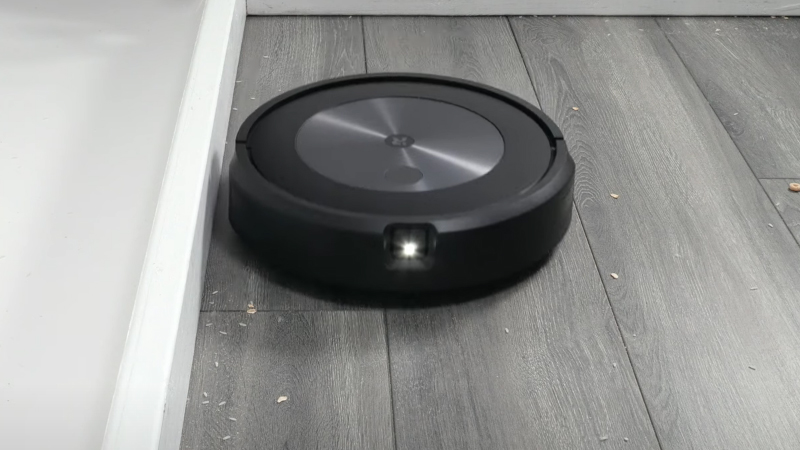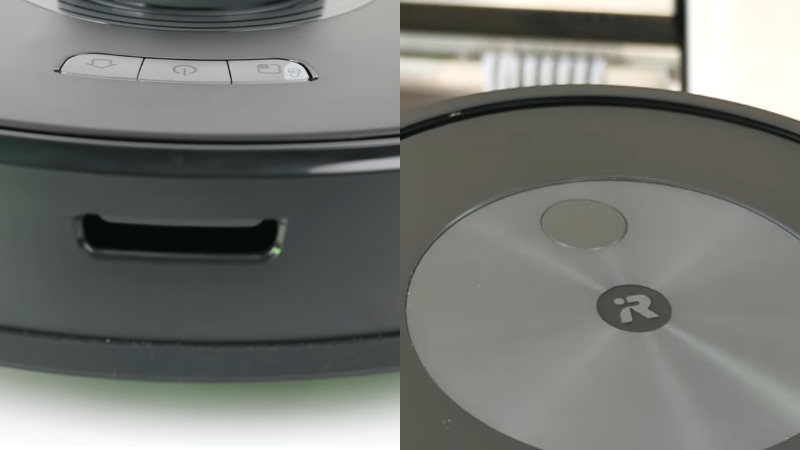Honestly, I always feel thrilled when comparing Roborock and iRobot since both have a reputation for releasing modern and smart robot vacuums. Today, I will be contrasting the Roborock Q7 Max vs iRobot J7, the flagships of their respective brands, to assist you in selecting the most suitable one for your household.
The Roborock Q7 Max, equipped with LiDAR navigation technology, can map environments swiftly and precisely, even in conditions with minimal light. Its mop unit isn’t really excellent, but it’s still ideal for a daily quick mop. The Roborock app itself is user-friendly and laden with additional features and functionalities to optimize the robot’s performance.
On the other hand, the iRobot J7‘s biggest selling point is that it can detect obstacles and intelligently avoid them. This one also has commendable cleaning performance on both hard floors and carpets, while its dual all-rubber brush rollers do a great job of preventing tangles.
Roborock Q7 Max Vs iRobot J7: Comparison Chart




Roborock Q7 Max Vs iRobot J7: Differences
The Roomba J7+ holds a 3-2 victory over the Roborock Q5+. Here is my in-depth comparison between these two powerhouse machines!
Cleaning Performance
Winner: Roborock Q7 Max
Hard Floor
| Roborock Q7 Max | Roomba J7 |
|---|---|
| ≈ 97% | ≈ 95% |
Both the Roborock Q7 and iRobot J7 worked great on my hard floor, with the former picking up a higher percentage of up to 97% on this surface – one of the best scores in the realm of robot vacuums.
Carpet
| Roborock Q7 Max | Roomba J7 | |
|---|---|---|
| Low-pile Carpet | ≈ 94% | ≈ 92% |
| High-pile Carpet | ≈ 95% | ≈ 96% |
I also conducted tests with them on carpets, where they proved to be proficient carpet cleaners. While not the leading ones in the industry for cleaning such surfaces, they still surpassed nearly all other robot vacuums I’ve tested.
Hair Pet
| Roborock Q7 Max | Roomba J7 | |
|---|---|---|
| 5-inch Strands | ≈ 87% | ≈ 72% |
| 10-inch Strands | ≈ 61% | ≈ 56% |
The Roborock S7 once again exhibited superior performance in collecting hair, including both 5- and 10-inch strands, attributed to its enhanced airflow. There was a decent amount of hair getting tangled in their roller. The lack of bristles indeed facilitated effortless untangling.

Design & Usability
Winner: iRobot J7
Dimensions & Weight
| Roborock Q7 Max | Roomba J7 | |
|---|---|---|
| Dimensions (W x H) | 13.8 x 3.80 inches | 13.3 x 3.4 inches |
| Weight | 8.38 lbs | 7.49 lbs |
The Q7 Max and iRobot J7 are overall high-quality but not exceptional in their looks. They are similar in shape: both feature a round-shaped minimalist frame with just a few physical buttons since most of their features are accessed via the Roborock and iRobot apps.
The Q7 Max is slightly wider and taller because of its LiDAR sensor in a raised tower, making it more difficult to fit beneath some lower-clearance furniture pieces. The Q7 is also slightly heavier than the J7, but the discrepancy is negligible.
Extractor & Side Brush
The next difference between them is the main brush roller. The Q7 features a single bristle-less roller, while the J7 uses iRobot’s patented counter-rotating rubber brushes for better debris pick-up.

The rubber brushes are indeed one of the biggest pros of these robots since their bristle-less design allows them to resist hair tangles better. Well, I agree that they aren’t a bulletproof solution, as my tests show that they still need a bit of a cleanup at the end of the day, but at least they didn’t get tangled in large amounts of hair in the same way that traditional combo brushes would.

The J7 uses a single 3-arm side brush compared to the 5-prong one on the Q7 Max to sweep debris into the main cleaning path. Like all the new Roborock, the Q7 Max uses an all-rubber side brush, which offers better longevity than the iRobot J7’s bristled one.
Navigation
Both the Q7 Max and J7 are mart-navigating robots that move in straight lines for thorough cleaning, but they use different technologies to map out your living space. The Q7 uses LiDAR (light detection and ranging), while the J7 uses vSLAM camera-based navigating technology. You’ll see a hockey ball-shaped turret housing the laser sensor above the Q7 Max that uses laser beams to scan around for mapping, while the J7 uses a front-facing camera to “see” around.

Using laser beams means the Q7 Max can map environments with increased speed and precision, even in conditions of low light or complete darkness, while the built-in camera on the iRobot J7 requires adequate lighting to operate effectively. iRobot engineers have fitted the J7 with an LED headlight to enhance its low-light performance, but it’s still not really a big plus.

It must have been a prolonged wait for pet owners for a robot vacuum cleaner capable of avoiding pet waste, and finally, the iRobot J7 is among the ones that make that dream come true. Yes, its obstacle avoidance ability with PrecisionVision navigation technology is really a game changer. Unlike its predecessors, its camera is on the front rather than being top-mounted, so it can “see” common obstacles and bypass them entirely.
Throughout my testing, the J7 adeptly navigated around typical obstructions ranging from shoes and cups to thin cables and artificial pet waste. This one is not perfect, but importantly, it can get smarter over time. For objects beyond its understanding, the J7 will take photos and “ask” for your opinion via the app so you can decide for yourself what it should do with them both presently and subsequently.
Both are ideal choices for multi-story apartments since they can save multiple maps for different floors. While the Q7 Max can save 4 floor plans, the iRobot J7 holds an advantage with the ability to memorize up to 10 incredible levels. So if you are the owner of a building, the latter is definitely your best bet.
Battery Life
| Roborock Q7 Max | Roomba J7 | |
|---|---|---|
| Battery Life | ≈ 91-183 mins | ≈ 101 mins |
| Charging Time | ≈ 198 mins | ≈ 120 mins |
The Q7 Max uses a large 5,200mAh battery, resulting in a significantly longer battery life compared to the 2210 battery on the J7. But their battery life is a lesser concern, at least for me, since the “recharge and resume” function is available for both. When these bots are close to running out of juice, they independently navigate back to their docking stations to recharge and subsequently resume their tasks from where they were interrupted.
Control
Winner: Roborock Q7 Max
Manual Control
You also need to download the respective app to unlock the full potential of these smart robots. Nonetheless, both are equipped with one or more physical buttons, providing a quick way to initiate a cleaning cycle without the necessity of retrieving your phone.
The Q7 Max has a set of three control buttons atop it for docking, starting cleaning, and cleaning a spot. The spot clean option, as its name suggests, is particularly convenient for localized clean-ups like coffee spills in the living room or BBQ sauce stains in the kitchen, for example.
The J7, on the other hand, is simplified with a single button that can be pressed once to start a cleaning cycle and once to stop it, or you can make a long tap to have it head over to its base. It doesn’t have a spot-cleaning button, but you can set clean zones via the app as an alternative.

App Connectivity
The Q7 Max and iRobot J7 can be paired with your smartphone via apps to get the most out of them. Both are free to download and share a variety of features, but the Q7 Max, with its Roborock app, stands out with some superior functionalities.
Both apps can save multiple maps and allow you to edit them, including the segmentation and labelling of rooms, executing cleaning tasks by room names, establishing “no-go” zones, and programming cleaning schedules. Both apps also let you keep an eye on parts like filters and brush rolls so you know when they need a replacement. Initiating a cleaning cycle or directing the cleaning of specific rooms through voice commands via Alexa or Google Assistant is also feasible.
Speaking of differences, the Roborock app has an “invisible wall” option, which is similar to no-go zones in terms of functionality but more flexible than just blocking the robot from going into the rectangular or square zones. This app has a live map as well, showing the real-time position of the Q7 Max on the map – So if something goes wrong, you can fix it promptly instead of looking for a needle in a haystack.
The iRobot also has some special functions. As mentioned before, it enables you to draw clean zones where more focused cleaning is needed and has the “Clwan When I Leave” option to engage the Q7 Max while you are away.
Cleaning & Maintenance
Winner: Tie
The Q7 Max features a conjoined dirt and water container with capacities of 0.47 and 0.35 liters, respectively, while the one on the iRobot J7 has a capacity of 0.5 liters. Both use a HEPA filter to trap all the hair, dust, and particulates, but the one that comes with the Q7 Max is washable, so you don’t have to worry about constant replacements.

The thing is that they don’t come with self-cleaning bases, so you will need to empty their dust boxes manually when they get full. This can be an inconvenience because not everyone can keep an eye on their robots throughout the vacuuming process, not to mention that this can cause some of the dirt and allergens to spread back into the air. If you want to get an auto-empty dock, you need to consider their “Plus” versions: Q7 Max+ or J7+ but be prepared to adjust your budget accordingly.
Other Features
Winner: Roborock Q7 Max
Noise
| Roborock Q7 Max | Roomba J7 | |
|---|---|---|
| None | ≈ 59-75 dB | ≈ 57 dB |
| Self-Emptying | None | None |
As for the volume, the Roomba J7 is quite quiet, while the Q7 Max is slightly noisier. Of course, this is understandably a trade-off you have to accept when selecting a vacuum renowned for its high suction capability.
Mopping Ability
Another cool feature of the Q7 Max is its electronic mopping system, which includes a hybrid water container and mopping pad. After you fill the water tank, it will electronically disperse water into the mop pad to thoroughly wet it.

The mop pad of the Q7 Max lacks the vibrating feature present in the Roborock S7 MaxV, leading to a compromise in cleaning efficiency. This one still applies enough pressure to clean day-to-day stains and spills, such as pet pawprints or milk spills, in just a single pass but faces challenges with more resilient stains, such as dried BBQ sauce.
Another omission is that it lacks the mop-lifting system, which is a must-have feature if your house has carpets and you don’t want to move the wet mopping pad and reattach it continuously. Therefore, it is recommended to delineate no-mop zones on the app for your carpets to keep them from getting wet or to remove them entirely before setting the Q7 Max to mop.
Quick Rundown Of Roborock Q7 Max
- Deeper Cleaning with Powerful 4,200 Pa Suction: With 4,200 Pa maximum suction, the Q7 Max effortlessly lifts debris and pet hair from floors, drags dirt from cracks, and deep-cleans carpets; it automatically boosts suction when carpets are detected, ensuring thorough cleaning
- Vacuum and Mop Simultaneously: To eliminate fine dust that vacuuming alone might miss, this robot vacuum can vacuum and mop in one go; its electronic pump offers 30 adjustable water flow levels, allowing you to customize cleaning based on floor type and preference
- Clean Smarter with PreciSense LiDAR Navigation: Highly accurate LiDAR technology builds precise 3D maps of your home and identifies the most efficient cleaning routes; virtually recreate your space by adding furnishings and flooring materials for a more tailored cleaning experience
- Combined Dustbin & Water Tank: The 470 ml dustbin and 350 ml water tank combination supports longer cleaning sessions without the need for frequent emptying or refilling
- Effortless Cleaning with All-Rubber Brush: The all-rubber brush is specifically designed to resist tangles from long hair and pet hair; its multi-directional floating design maintains close contact with the floor, ensuring deeper and more efficient cleaning
Quick Rundown Of iRobot J7
- CLEANS WHEN & WHERE YOU WANT– Only iRobot brings you Imprint Smart Mapping allowing you to control & schedule which rooms are cleaned and when, while storing multiple maps for easier cleaning on each level of your home; Plus customizable Keep Out Zones and Clean Zones allow you to tell them the exact area to avoid and clean
- DOESN'T GET HUNG UP; JUST GETS IT DONE; - A full suite of advanced sensors allow this robot to navigate under and around furniture, and along edges, while Cliff Detect keeps it from falling down the stairs
- SET TO AUTOMATICALLY CLEAN WHEN YOU'RE AWAY - Now with iRobot Genius, you can choose to set your robot to automatically start cleaning when you leave and stop when you come home, so you only notice the clean and never the cleaning
- Only iRobot brings you Imprint Smart Mapping allowing you to control and schedule which rooms are cleaned and when, while storing multiple maps for easier cleaning on each level of your home; Plus customizable Keep Out Zones and Clean Zones allow you to tell them the exact area to avoid and clean
Product Videos
Related Articles to Roomba J7
- Roomba i4 vs j7: Compare An Entry-Level vs. A Premium Vacuum
- Roomba i3 vs j7: A Clash of Premium vs. Entry-Level Models
- Roomba J7 Vs J7+: What Is The Difference?
Related Articles to Roborock Q7 Max
- Roborock Q5+ Vs Q7 Max: Which Roborock Robot Should You Choose?
- An In-Depth Review Of The Roborock Q7 Max Vs Dreame L10 Pro: Which is Better?
- Roborock Q7 Max Vs S7: What Are the Differences Between Them?
- Roborock Q5 Vs Q7 Max: An In-Depth Analysis
- Roborock Q7 Max Vs Xiaomi S10T: A Detailed Comparison
- Roborock Q7 Max Vs Eufy X8: What Is The Best Option For Your Home?
- Viomi S9 Vs Roborock Q7 Max: Battle of the Feature-Rich Bots
- Viomi V5 Pro Vs Roborock Q7 Max: Which One Gets My Winning Ticket?
- Roborock Q7 Max Vs Dreame Z10 Pro: A Detailed Face-Off Comparison
- Roborock Q Revo Vs Q7 Max: Duel of the Roborock Dust-Suckers
- Dreame D10 Plus Vs Roborock Q7 Max: An In-Depth Comparison And Review
- Roborock Q7 Max Vs Q7: What Does The “Max” Label Refer To?
- Dreame D9 Max Vs Roborock Q7 Max: Which Chinese Brand Does the Job Better?
- Roborock Q7 Max Vs Q7 Max Plus: Is the Self-Cleaning Base A Game Changer?
- Roborock Q7 Max Vs S7 MaxV: Which Roborock Is Better?
References:
- iRobot J7: https://www.irobot.com/en_US/roomba-j7-robot-vacuum/J715020.html
- Roborock Q7 Max: https://us.roborock.com/products/roborock-q7-max

Richard B. Schmidt is a prominent figure in the vacuum cleaner industry, boasting over 15 years of expertise. Armed with a Robotics Engineering degree from Northeastern University and a Master’s in Consumer Science from Harvard, his unique blend of technical knowledge and consumer insights positions him as a sought-after authority in vacuum cleaner evaluation. Richard’s career began at Dyson, where he contributed to the development of innovative vacuum models. Transitioning to advocacy and reviews, he co-founded the first Vacuum-focused blog in 2008, offering comprehensive analysis and user guides for various vacuum cleaners. In 2020, he founded RoboMop.net, providing ongoing insights through columns and buyer’s guides.
